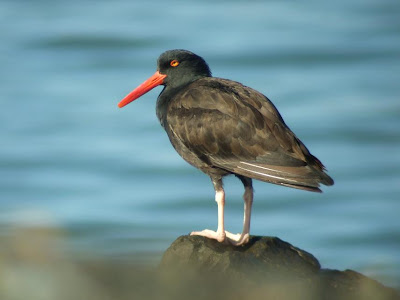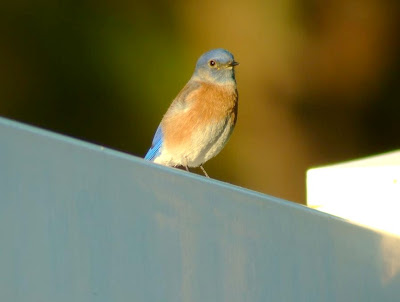The title says it all - I went on my first pelagic trip with Shearwater Journeys on Saturday, out of Monterey Bay. We made the roughly seven hour drive up on Friday. The weather was nasty, with rain and dark clouds. I didn't get to do any serious birding, but I got a lame start to my Kern, San Louis Obispo, and Monterey County lists. There was a flock of tame Brewer's Blackbirds roaming the parking lot at a rest area along Route 46 in San Louis Obispo County - very common birds I realize, but this is my first photograph of this species.

The next morning I awoke early and my dad drove me to Fisherman's Wharf, where the boat departed from. After Debi Shearwater gave a brief orientation, we pulled out of the harbor and were on our way! We couldn't find the Harlequin Ducks than had been around earlier in the week, but we did see lots of Brandt's Cormorants and California Sea Lions on the breakwater, along with a few Black Turnstones. Here's a shot of a friendly Brandt's Cormorant that was right next to the boat. Those turquoise eyes are really neat!

Just after we rounded the breakwater, someone called out a Common Murre sitting on the water. Sure enough, there it was floating on the waves - my first lifer of the day. Here's a highly cropped image of it:

A short time later, we came across a pair of Rhinoceros Auklets bobbing around, occasionally diving. We were able to maneuver quite closely to them, but I didn't get any photos. Once we got a little farther out at sea, things got more and more exciting. The cry of "Buller's [Shearwater]!" came up from the bow. I saw them, but they were very distant. Then some Pink-footed Shearwaters came gliding in right across the bow, only to be followed by a couple Northern Fulmars which put on a great show by flying right in front of the boat. Suddenly, several birders screamed "ALBATROSS!" at the top of their lungs at the same time. Sure enough, a Black-footed Albatross came gliding in, dwarfing the shearwaters. It flew right down one side of the boat, giving excellent looks. The boat flushed a Cassin's Auklet off the water as well. The auklet unfortunately flew straight away from the bow of the boat, and I was one of the few who managed to get on the bird. Here's a shot of a small flock of Pink-footed Shearwaters sitting on the water.

Several Pomerine Jaegers also appeared, including one beautiful light-phase adult with full tail spoons. We left the shearwaters and struck out over a relatively birdless expanse of ocean, chasing a large group of dolphins which had been reported several miles away. The leaders quickly spotted the dolphins, along with masses of birds hanging out with them! As we approached the frenzy, a South Polar Skua lumbered by, much to the delight of the birders. There were hundreds of dolphins feeding in the area. We saw two species: Pacific White-sided Dolphin and Northern Right Whale Dolphin. Here's a shot of a group of White-sides surfacing:

There were fewer Right Whale Dolphins, but there were still quite a few. What cool animals!

The birds were really flocking around the dolphins. There were lots of shearwaters of the three species I mentioned before, plus two Flesh-footed Shearwaters. Flesh-foots are pretty rare here, and do not show up every fall. I got great looks at them, but alas no photos. I was happy to see some small flocks of Red Phalaropes - I'm still amazed that such small birds can thrive over twenty miles out at sea! A Sabine's Gull also made a brief and distant appearance. There were lots of Northern Fulmars around as well, with a few very pale individuals and a few very dark individuals. However, most were a medium gray color. Here's a shot of one taking off the water, probably my favorite shot of the day.

I could have stayed out on the sea forever looking for seabirds, but unfortunately we had to turn back and return to land in mind-afternoon. I was very happy with the trip, since I got thirteen lifers: Black-footed Albatross, Northern Fulmar, Pink-footed Shearwater, Flesh-footed Shearwater, Buller's Shearwater, Sooty Shearwater, Red Phalarope, South Polar Skua, Pomarine Jaeger, Sabine's Gull, Common Murre, Cassin's Auklet and Rhinoceros Auklet. I was disappointed about the lack of storm-petrels, but it's getting a tad late in the season for them. I'll have to go back earlier in the fall next year and see them!
On Sunday we drove back down to Orange County. We took Pacific Coast Highway south to Morro Bay, which was very scenic. During a brief stop at a gas station in Big Sur I found my first Chesnut-backed Chickadees, which I was very happy about! We also stopped at a beach in San Luis Obispo County to see Elephant Seals hauled out on the beach. Look at that cute face!

We had lunch at Santa Margarita Lake Park in San Louis Obispo County with my mom's cousin Jan Surbey, who is a serious birder and the president of the Morro Bay Audubon Society. I found my first Golden-crowned Sparrows of the fall there, along with lots of Clark's Grebes, and singles of Northern Pintail and Gadwall. On the way out, along Pozo Road, I spotted a small flock of about five Yellow-billed Magpies in flight near the road. We stopped, and I quickly located several other calling individuals in the trees right next to the road. My fifteenth and final lifer of the trip! A great way to end an excellent trip.













































